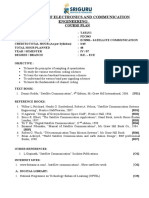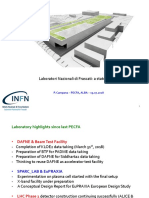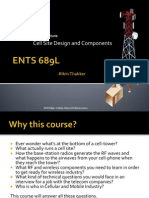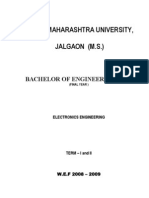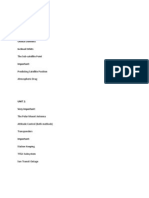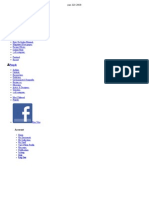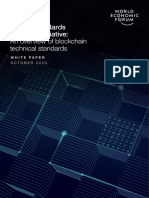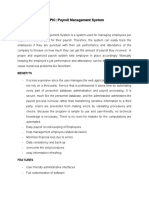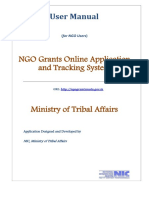Satellite Communication Notes Ec6004
Satellite Communication Notes Ec6004
Uploaded by
Vemuganti RahulCopyright:
Available Formats
Satellite Communication Notes Ec6004
Satellite Communication Notes Ec6004
Uploaded by
Vemuganti RahulOriginal Description:
Original Title
Copyright
Available Formats
Share this document
Did you find this document useful?
Is this content inappropriate?
Copyright:
Available Formats
Satellite Communication Notes Ec6004
Satellite Communication Notes Ec6004
Uploaded by
Vemuganti RahulCopyright:
Available Formats
FT/GN/68/01/23.01.
16
SRI VENKATESWARA COLLEGE OF ENGINEERING
COURSE DELIVERY PLAN - THEORY Page 1 of 7
LP: EC6004
Department of Electronics and Communication Engineering
Rev. No:00
B.E/B.Tech/M.E/M.Tech : BE-EC Regulation:2013 Date:04/07/2016
PG Specialisation : Not Applicable
Sub. Code / Sub. Name : EC6004-SATELLITE COMMUNICATION
Unit :I
UNIT – I SATELLITE ORBITS
Syllabus
Kepler‟s Laws, Newton‟s law, orbital parameters, orbital perturbations, station keeping, geo
stationary and non Geo-stationary orbits – Look Angle Determination- Limits of visibility –
eclipse-Sub satellite point –Sun transit outage-Launching Procedures - launch vehicles and
propulsion.
Objective
Analysis of Satellite parameters and derive the equations of orbit studying the procedures
of launching.
Session Topics to be covered Ref Teaching
No. Method
1 Kepler’s laws T1 PPT
2 Newton’s Law, Definitions of Terms for Earth-orbiting T1,R8 PPT
Satellites orbital parameters
3 Orbital perturbations- effects of non-spherical earth, T1,R2 PPT
atmospheric drag, Station Keeping
4 Geo-stationary orbits & non geo-stationary orbits- T1,R2 PPT
geometry
5 Look Angle Determination, Limits of Visibility T1,R2,R3 PPT
6 Earth eclipse of satellites, Sub satellite point T1 PPT
7 Sun transit outage, Launching Procedures-Direct, T1,R1,R8 PPT
Insertion to GTO
8 Launch vehicles and propulsion-principles, rocket R1 PPT
equation, powered flight, injection into final orbit.
9 Problems T1,R1,R8 BB/PPT
Content beyond syllabus covered (if any):Equations of orbit
* Session duration: 50 minutes
FT/GN/68/01/23.01.16
SRI VENKATESWARA COLLEGE OF ENGINEERING
COURSE DELIVERY PLAN - THEORY Page 2 of 7
FT/GN/68/01/23.01.16
SRI VENKATESWARA COLLEGE OF ENGINEERING
COURSE DELIVERY PLAN - THEORY Page 3 of 7
Sub. Code / Sub. Name: EC6004-SATELLITE COMMUNICATION
Unit : II
UNIT – II SPACE SEGMENT AND SATELLITE LINK DESIGN
Syllabus
Spacecraft Technology- Structure, Primary power, Attitude and Orbit control, Thermal control
and Propulsion, communication Payload and supporting subsystems, Telemetry, Tracking and
command. Satellite uplink and downlink Analysis and Design, link budget, E/N calculation-
performance impairments-system noise, inter modulation and interference, Propagation
Characteristics and Frequency considerations- System reliability and design lifetime.
Objective
To study about space segment and components and link design procedures.
Session Teaching
Topics to be covered Ref
No * Aids
10 Space craft Design, Subsystems, structure primary T1 PPT
power estimating power needs
11 Solar array requirements Thermal Subsystem- T1 PPT
Control
12 Attitude and Orbit control subsystem T1 PPT
13 Telemetry Tracking & Command Subsystem, T1 PPT
attitude control, propulsion subsystems
14 Transponders- Wideband Receiver – Input T1 PPT
Demultiplexer,
15 Power Amplifier, Antenna Subsystem T1 PPT
CAT-I
16 Uplink-saturation flux density, input backoff, T1 BB/PPT
17 Downlink –output backoff, TWTA output, Link T1 BB/PPT
budget, E/N calculation
18 Performance impairments-system noise, inter T1 BB/PPT
modulation and interference, Propagation
Characteristics and Frequency considerations, System
reliability and design lifetime.
Content beyond syllabus covered (if any):Characteristics and behavior of communication channel.
* Session duration: 50 mins
FT/GN/68/01/23.01.16
SRI VENKATESWARA COLLEGE OF ENGINEERING
COURSE DELIVERY PLAN - THEORY Page 4 of 7
Sub. Code / Sub. Name: EC6004-SATELLITE COMMUNICATION
Unit : III
UNIT III EARTH SEGMENT
Introduction – Receive – Only home TV systems – Outdoor unit – Indoor unit for analog (FM)
TV – Master antenna TV system – Community antenna TV system – Transmit – Receive earth
stations – Problems – Equivalent isotropic radiated power – Transmission losses – Free-space
transmission – Feeder losses – Antenna misalignment losses – Fixed atmospheric and ionospheric
losses – Link power budget equation – System noise – Antenna noise – Amplifier noise
temperature – Amplifiers in cascade – Noise factor – Noise temperature of absorptive networks –
Overall system noise temperature – Carrierto- Noise ratio – Uplink – Saturation flux density –
Input back off – The earth station - HPA – Downlink – Output back off – Satellite TWTA output –
Effects of rain – Uplink rain– Fade margin – Downlink rain – Fade margin – Combined uplink
and downlink C/N ratio – Inter modulation noise.
Objective
To study about Earth Segment and Test equipment measurements.
Session Teaching
Topics to be covered Ref
No * Aids
19 Introduction – Receive – Only home TV systems – Outdoor 4 PPT
unit – Indoor unit for analog (FM) TV
20 Master antenna TV system – Community antenna TV system T1 PPT
– Transmit – Receive earth stations – Problems
21 Equivalent isotropic radiated power – Transmission losses – T1 PPT
Free-space transmission
22 Feeder losses – Antenna misalignment losses – Fixed T1 PPT
atmospheric and ionospheric losses
23 Link power budget equation – System noise – Antenna noise T1,R1,R2,R3 PPT
– Amplifier noise temperature
24 Amplifiers in cascade – Noise factor – Noise temperature of T1,R6 PPT
absorptive networks
25 Overall system noise temperature – Carrier-to- Noise ratio – T1,R6 PPT
Uplink – Saturation flux density
26 Input back off – The earth station - HPA – Downlink – Output T1,R1 PPT
back off – Satellite TWTA output – Effects of rain – Uplink
rain– Fade margin
27 Downlink rain – Fade margin – Combined uplink and R9 PPT
downlink C/N ratio – Inter modulation noise
Content beyond syllabus covered (if any): nil
* Session duration: 50 mins
FT/GN/68/01/23.01.16
SRI VENKATESWARA COLLEGE OF ENGINEERING
COURSE DELIVERY PLAN - THEORY Page 5 of 7
Sub. Code / Sub. Name: EC6004-SATELLITE COMMUNICATION
Unit : IV
UNIT – IV SATELLITE ACCESS
Syllabus
Modulation and Multiplexing: Voice, Data, Video, Analog – digital transmission system, Digital
video Brocast, multiple access: FDMA, TDMA, CDMA, Assignment Methods, Spread Spectrum
communication, compression – encryption.
Objective
To evaluate various analog and digital modulation, multiplexing and multiple access techniques and
design communication link budget accordingly.
Session Teaching
Topics to be covered Ref
No * Aids
28 Modulation-Frequency modulation –waveform R5,R6,R7,R8 PPT
equation, carson’s rules
29 Digital transmission-baseband transmission, band R4, R7,R8 PPT
pass transmission, transmission of QPSK signals
30 Analog FM transmission, TV signals, SNR ratio for R4, R5,R8 PPT
FM video transmission
31 Baseband signals- voice, data, digital transmission R4, R6,R8 PPT
system, Digital video Broadcast
32 Multiple Access-FDMA-MCPC, SCPC, trade-off T1,R6 PPT
analysis, disadvantages
CAT-II
33 TDMA-preamble & postamble, carrier recovery, T1 PPT
unique word detection, speech interpolation
34 Preassigned TDMA, Demand-assigned TDMA T1 PPT
35 CDMA- Direct sequence spread spectrum T1 PPT
36 Spread spectrum communication-Types, Direct T1,R7 PPT
sequence, frequency hopping, compression –
encryption
Content beyond syllabus covered (if any):Very broad comparison of access techniques
* Session duration: 50 mins
Sub. Code / Sub. Name: EC6004-SATELLITE COMMUNICATION
FT/GN/68/01/23.01.16
SRI VENKATESWARA COLLEGE OF ENGINEERING
COURSE DELIVERY PLAN - THEORY Page 6 of 7
Unit : V
UNIT – V SATELLITE APPLICATIONS
Syllabus
INTELSAT Series, INSAT, VSAT, Mobile satellite services: GSM, GPS, INMARSAT, LEO,
MEO, Satellite Navigational System. Direct Broadcast satellites (DBS)- Direct to home
Broadcast (DTH), Digital audio broadcast (DAB)- Worldspace services, Business TV(BTV),
GRAMSAT, Specialized services – E –mail, Video conferencing, Internet.
Objective
Study of Satellite applications & specialized services
Session Teaching
Topics to be covered Ref
No * Aids
37 INTELSAT Series, INSAT T1 ICT/PPT
38 VSAT, Mobile satellite servies-GSM T1 PPT
39 GPS, INMARSAT, LEO, MEO T1 PPT
40 Satellite Navigational System, DBS T1 PPT
41 Direct to home Broadcast (DTH) R4 PPT
42 Digital audio broadcast (DAB) R4 PPT
43 World space services, Business TV(BTV) R4 PPT
44 GRAMSAT, Specialized services – Email R4 PPT
45 Video conferencing, Internet R4 PPT
Content beyond syllabus covered (if any): nil
* Session duration: 50 mins
FT/GN/68/01/23.01.16
SRI VENKATESWARA COLLEGE OF ENGINEERING
COURSE DELIVERY PLAN - THEORY Page 7 of 7
Sub Code / Sub Name: EC6004-SATELLITE COMMUNICATION
TEXT BOOK:
1. Dennis Roddy, “Satellite Communication”, 4th Edition, Mc Graw Hill International, 2006. 86
REFERENCES:
1. Wilbur L.Pritchard, Hendri G. Suyderhoud, Robert A. Nelson, “Satellite Communication Systems
Engineering”, Prentice Hall/Pearson, 2007.
2. N.Agarwal, “Design of Geosynchronous Space Craft”, Prentice Hall, T1986.
3. Bruce R. Elbert, “The Satellite Communication Applications”, Hand Book, Artech House Bostan
London, T1997.
4. Tri T. Ha, “Digital Satellite Communication”, II nd edition, T1990.
5. Emanuel Fthenakis, “Manual of Satellite Communications”, Mc Graw Hill Book Co., T1984.
6. Robert G. Winch, “Telecommunication Trans Mission Systems”, Mc Graw-Hill Book Co., T1983.
7. Brian Ackroyd, “World Satellite Communication and earth station Design”, BSP professional Books,
T1990.
8. G.B.Bleazard, “Introducing Satellite communications“, NCC Publication, T1985.
9. M.Richharia, “Satellite Communication Systems-Design Principles”, Macmillan 2003.
* If the same lesson plan is followed in the subsequent semester/year it should be mentioned and signed by
the Faculty and the HOD
Prepared by Approved by
Signature
Name M.H.MASOOD Dr.S.MUTHUKUMAR
Designation ASSISTANT PROFESSOR/EC HOD/EC
Date 04.07.2016 04.07.2016
Remarks *:
Remarks *:
* If the same lesson plan is followed in the subsequent semester/year it should be
mentioned and signed by the Faculty and the HOD
You might also like
- Practice Exam Questions For Nokia Optical Networking Fundamentals (Exam Number: 4A0-205)Document5 pagesPractice Exam Questions For Nokia Optical Networking Fundamentals (Exam Number: 4A0-205)Andrei MarchankaNo ratings yet
- EC3354 Signals and SystemsDocument58 pagesEC3354 Signals and SystemsheraldNo ratings yet
- Basic Electrical and Electronics EngineeringDocument119 pagesBasic Electrical and Electronics EngineeringNlrNo ratings yet
- Ae Zg511 Course HandoutDocument4 pagesAe Zg511 Course HandoutJoel George AlexNo ratings yet
- EA ManualDocument13 pagesEA Manualmangelbel6749100% (2)
- Satellite Communication Lesson Plan 2018Document11 pagesSatellite Communication Lesson Plan 2018Raja PirianNo ratings yet
- Department of Electronics and Communication Engineering: Course PlanDocument7 pagesDepartment of Electronics and Communication Engineering: Course PlanselviNo ratings yet
- Satellite CommunicationDocument7 pagesSatellite CommunicationShakiraNo ratings yet
- Subject: Communication Theory: Department of Electronics and Communication EngineeringDocument12 pagesSubject: Communication Theory: Department of Electronics and Communication EngineeringponniNo ratings yet
- Antennas and Radiation Mechanism of Various Antennas and Antenna ArraysDocument11 pagesAntennas and Radiation Mechanism of Various Antennas and Antenna ArrayssridharchandrasekarNo ratings yet
- PE 824 EC Satellite Communications Elective: DC Pc601Ec 3 - 30 70 3 Course ObjectivesDocument2 pagesPE 824 EC Satellite Communications Elective: DC Pc601Ec 3 - 30 70 3 Course ObjectivesCarey JohnNo ratings yet
- EC2045Document7 pagesEC2045Geoffrey AlleyneNo ratings yet
- Slides Campana Campana 20170719 PEcfaDocument19 pagesSlides Campana Campana 20170719 PEcfaBenjamín Varela UmbralNo ratings yet
- Ist PDFDocument45 pagesIst PDFP JogamayaNo ratings yet
- Handout SASDocument2 pagesHandout SASJeswin EldhoNo ratings yet
- Course No.: SEMB ZC482 Course Title: Satellite CommunicationDocument3 pagesCourse No.: SEMB ZC482 Course Title: Satellite CommunicationSakthi VelNo ratings yet
- EC8352 LessonPlanDocument7 pagesEC8352 LessonPlanramarajanNo ratings yet
- Electrical Engineering: IndexDocument35 pagesElectrical Engineering: IndexRizwan 106No ratings yet
- Engineering", Pearson Education, 2: RD NDDocument1 pageEngineering", Pearson Education, 2: RD NDhariNo ratings yet
- Eeef111 EsDocument2 pagesEeef111 EsYash BhardwajNo ratings yet
- Course Syllabi (2016 - 2020) : Format No.: MITAOE/ACAD/ 002 Rev. No.: 0.0 Rev. Date: 01/12/2017Document4 pagesCourse Syllabi (2016 - 2020) : Format No.: MITAOE/ACAD/ 002 Rev. No.: 0.0 Rev. Date: 01/12/2017yogesh zalteNo ratings yet
- B.Tech (Data Science) Handbook@2023-24 20240101 133310Document22 pagesB.Tech (Data Science) Handbook@2023-24 20240101 133310Rizwan SaifiNo ratings yet
- EE Syllabus - 4thDocument14 pagesEE Syllabus - 4thNishant LambatNo ratings yet
- Satcom Hand OutDocument2 pagesSatcom Hand Outmayank7577No ratings yet
- 1101ENTS689L SyllabusDocument13 pages1101ENTS689L Syllabuslalli09No ratings yet
- Devais Elektronika SAPDocument2 pagesDevais Elektronika SAPMesah Yoga KarismaNo ratings yet
- Microwave MCQDocument1 pageMicrowave MCQtapan kumarNo ratings yet
- Government Polytechnic, Pune: ET2107 - NODocument8 pagesGovernment Polytechnic, Pune: ET2107 - NOG012 Bhise AniketNo ratings yet
- Basics of Satellite CommunicationsDocument70 pagesBasics of Satellite CommunicationsMAGU_MWENYEWE100% (2)
- Ec8491 - CTDocument90 pagesEc8491 - CTCHATHIRIYAN VNo ratings yet
- LTE From A Z Reloaded - v3.210 TOC PDFDocument9 pagesLTE From A Z Reloaded - v3.210 TOC PDFmeysamRajabiNo ratings yet
- Applied Electronic circuits booklet-1Document46 pagesApplied Electronic circuits booklet-1selvaram789No ratings yet
- Analog Integrated Circuits (TEC-502)Document12 pagesAnalog Integrated Circuits (TEC-502)ANUJ100% (3)
- EC8491 Notes PDFDocument90 pagesEC8491 Notes PDFgunasekaran kNo ratings yet
- UntitledDocument71 pagesUntitled203005 ANANTHIKA MNo ratings yet
- 6th Sem ETDocument18 pages6th Sem ETArman VermaNo ratings yet
- EC2045Document7 pagesEC2045Anonymous qe6qwE4aNo ratings yet
- Lesson Plan - Antennas & Wave Propagation (15EC604)Document25 pagesLesson Plan - Antennas & Wave Propagation (15EC604)Ramya100% (1)
- Electronics OutlineDocument2 pagesElectronics OutlineTanasha WayneNo ratings yet
- Syllabus CseDocument1 pageSyllabus Csejagan.venkatesan11No ratings yet
- Satellite CommunicationDocument3 pagesSatellite CommunicationApurv PatelNo ratings yet
- Birla Institute of Technology and Science, Pilani Birla Institute of Technology and Science, Pilani Birla Institute of Technology and Science, PilaniDocument2 pagesBirla Institute of Technology and Science, Pilani Birla Institute of Technology and Science, Pilani Birla Institute of Technology and Science, PilaniHarsh GroverNo ratings yet
- Advancing Fusion Energy On A Global ScaleDocument20 pagesAdvancing Fusion Energy On A Global Scaleknowledge3736 jNo ratings yet
- SyllabusDocument6 pagesSyllabuspranavjha.et21No ratings yet
- 2008-09 B. E. Electronics EngineeringDocument38 pages2008-09 B. E. Electronics Engineeringmohammed8051No ratings yet
- 3 ThirdDocument11 pages3 ThirdUday Abduljaleel AlhamdanyNo ratings yet
- 2.electronics DevicesDocument6 pages2.electronics DevicesanupNo ratings yet
- Curriculum Details - B.tech (CCA)Document5 pagesCurriculum Details - B.tech (CCA)JITHIN JACOB MATHEW 22BCE10674No ratings yet
- Electronic Devices and Circuits.Document8 pagesElectronic Devices and Circuits.Raja PirianNo ratings yet
- AWP UNIT 3Document27 pagesAWP UNIT 3Manohar UdayagiriNo ratings yet
- Awp Lesson PlanDocument4 pagesAwp Lesson PlanKasthuri NgarajanNo ratings yet
- Satellite ImpDocument3 pagesSatellite ImpConquering Praful MalviNo ratings yet
- Aei-5th & 6TH Sem23062008Document44 pagesAei-5th & 6TH Sem23062008War MachineNo ratings yet
- Quad 1Document28 pagesQuad 1prakhartripathi826No ratings yet
- EC6602 SCAD MSM by WWW - Learnengineering.inDocument248 pagesEC6602 SCAD MSM by WWW - Learnengineering.inAnonymous j6EyXxeBnRNo ratings yet
- Analytical and Numerical Models for TherDocument9 pagesAnalytical and Numerical Models for Therhawkings330No ratings yet
- Me Iii Sem MW190814040243Document7 pagesMe Iii Sem MW190814040243achin mponlineNo ratings yet
- 2yrs Mtech Ece Sem3Document3 pages2yrs Mtech Ece Sem3paku deyNo ratings yet
- Nanoelectronics Devices: Design, Materials, and Applications (Part I)From EverandNanoelectronics Devices: Design, Materials, and Applications (Part I)No ratings yet
- Connections Management Strategies in Satellite Cellular NetworksFrom EverandConnections Management Strategies in Satellite Cellular NetworksNo ratings yet
- Cheatsheet - 10 Strategies To Break Product Backlog ItemsDocument1 pageCheatsheet - 10 Strategies To Break Product Backlog ItemsDurgadas BhandaryNo ratings yet
- Pas 220 2008Document19 pagesPas 220 2008Hau SinâuđaNo ratings yet
- WEF GSMI Technical Standards 2020Document27 pagesWEF GSMI Technical Standards 2020ForkLogNo ratings yet
- Iso 10648-1Document33 pagesIso 10648-1saeed216No ratings yet
- Product Information Rockwell Hardness Tester ZHR4045/4150/8150Document4 pagesProduct Information Rockwell Hardness Tester ZHR4045/4150/8150Ricardo Morales MorenoNo ratings yet
- JarirDocument1 pageJarirMohammed FaisalNo ratings yet
- NEW Camera CGI Interface v4.30Document148 pagesNEW Camera CGI Interface v4.30Martin BudiNo ratings yet
- 02 PROT405 IntroductionIndustrialPower r4Document62 pages02 PROT405 IntroductionIndustrialPower r4Hector AguilarNo ratings yet
- Ohlins DTCDocument2 pagesOhlins DTCJosé J Rios RiosNo ratings yet
- Implementation of Electronic Governor & Control System of A Mini-Hydro Power PlantDocument6 pagesImplementation of Electronic Governor & Control System of A Mini-Hydro Power PlantbagastcNo ratings yet
- Lehf1835 07 Fiche Specification Insonorisee Serie Gepx GBDocument4 pagesLehf1835 07 Fiche Specification Insonorisee Serie Gepx GBHenry Michael100% (1)
- SST-CPE920 Wireless Bridge Specs (2024-05-23 22 - 38 - 01)Document3 pagesSST-CPE920 Wireless Bridge Specs (2024-05-23 22 - 38 - 01)Douglas QueirozNo ratings yet
- Payroll Management System Database ProjectDocument2 pagesPayroll Management System Database ProjectJed MorellNo ratings yet
- Intro To NetworkingDocument12 pagesIntro To NetworkingNilvic RaseNo ratings yet
- NGO Grants Online Application and Tracking System: User ManualDocument16 pagesNGO Grants Online Application and Tracking System: User ManualSKILL 2021No ratings yet
- EIKI - DPHD-P4603 LCD Splicing Screen 46 Inch PDFDocument10 pagesEIKI - DPHD-P4603 LCD Splicing Screen 46 Inch PDFcidNo ratings yet
- Installation Manual: A Product From Smart Optics Sensortechnik GMBHDocument41 pagesInstallation Manual: A Product From Smart Optics Sensortechnik GMBHAhmad GHNo ratings yet
- Ericsson Sample Technical Placement PaperDocument15 pagesEricsson Sample Technical Placement PaperPuli NaveenNo ratings yet
- Factorio Cheat Sheet v7-2023Document22 pagesFactorio Cheat Sheet v7-2023Alex NevskiyNo ratings yet
- PG1203Document17 pagesPG1203heriberto8280No ratings yet
- How To Allow Pings (ICMP Echo Requests) Through Your Windows Firewall - ADocument14 pagesHow To Allow Pings (ICMP Echo Requests) Through Your Windows Firewall - AKrol AnwarNo ratings yet
- Saej 2800 V 001Document5 pagesSaej 2800 V 001kyletgerberNo ratings yet
- Starting Gas TurbineDocument3 pagesStarting Gas Turbineanup_nair100% (3)
- GMC Truck CATALOGDocument3 pagesGMC Truck CATALOGTayfun SezişNo ratings yet
- Ölflex® Classic 110 Cy: Product InformationDocument5 pagesÖlflex® Classic 110 Cy: Product InformationPhaniNo ratings yet
- Eng - Mostafa AlhussienyDocument3 pagesEng - Mostafa AlhussienySasa BasNo ratings yet
- Frame Floor - Fault ListDocument64 pagesFrame Floor - Fault ListsurajNo ratings yet
- Message Encode Decode in PythonDocument9 pagesMessage Encode Decode in PythonRanu droliaNo ratings yet






